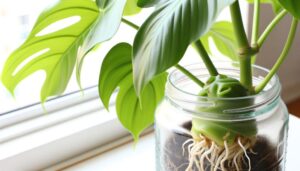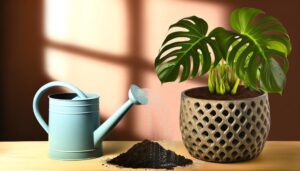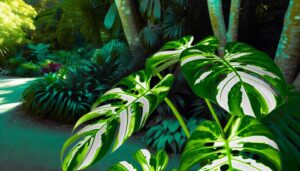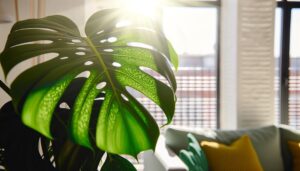Monstera Lechleriana Variegated: Unique Features!
Monstera lechleriana variegated, a rare cultivar in the Araceae family, boasts chimeric variegation with green and creamy white leaves. This tropical epiphyte climbs using aerial roots, often found in Central and South American rainforests.
Its ovate to elliptic leaves exhibit distinctive fenestrations. For robust growth, maintain temperatures between 65°F to 80°F (18°C to 27°C), high humidity above 60%, and provide bright, indirect light.
Use a peat, perlite, and orchid bark soil mix, watering when the top inch dries out. Fertilize monthly.
An understanding of its origin, care, and pests will optimize your plant’s health and beauty.
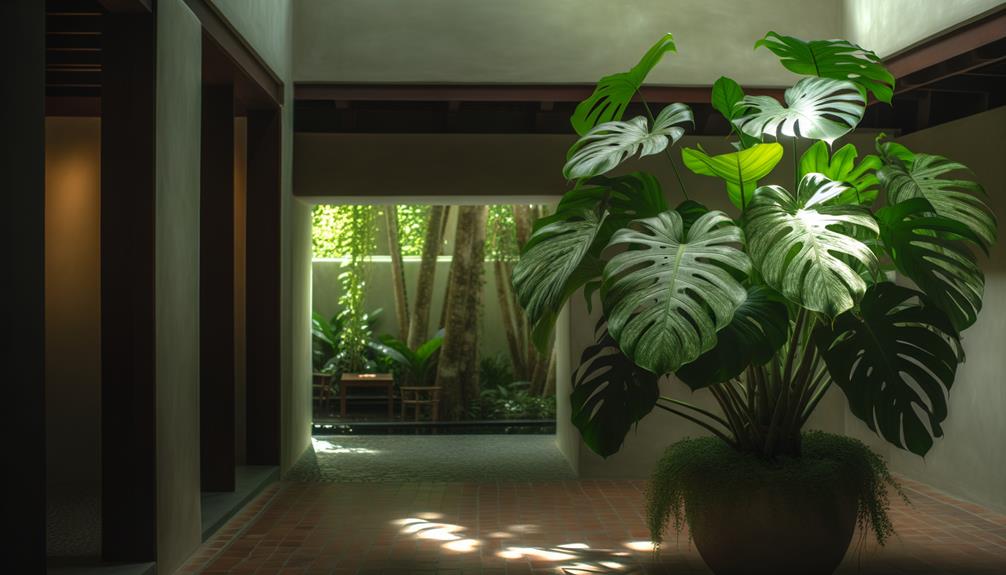
Key Takeaways
- Monstera lechleriana variegated is a rare cultivar with unique green and creamy white patterned leaves.
- It thrives in temperatures between 65°F to 80°F and humidity levels above 60%.
- Requires bright, indirect sunlight and a soil mixture of peat, perlite, and orchid bark for optimal growth.
- Water when the top inch of soil is dry and fertilize monthly with a balanced, water-soluble fertilizer.
- Regularly inspect for pests like spider mites and mealybugs and ensure proper drainage to prevent root rot.
Origins and History
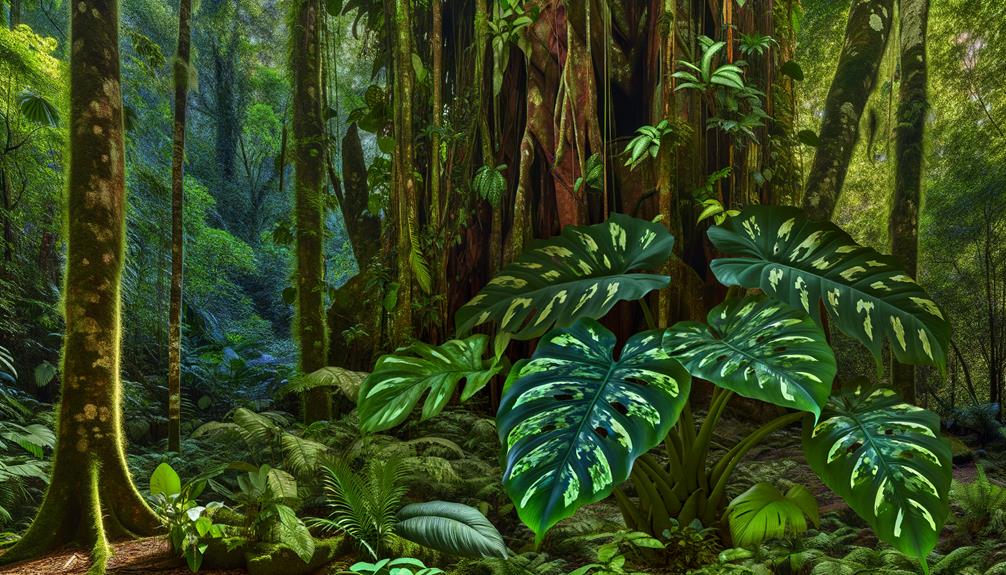
Originally discovered in the tropical rainforests of Central and South America, Monstera lechleriana variegated is a rare and sought-after cultivar known for its strikingly patterned leaves. This plant belongs to the Araceae family, thriving in humid, shaded environments. The genus Monstera, first classified by Friedrich Anton Wilhelm Miquel, includes various species renowned for their fenestrated foliage.
You’ll find Monstera lechleriana variegated mainly in the understory layer of the rainforest, where it climbs trees using its aerial roots. This epiphytic nature allows it to reach for sunlight while benefiting from the nutrient-rich organic matter found on tree surfaces.
Understanding its native habitat and growth conditions is essential for successfully cultivating this plant in non-native environments.
Unique Characteristics
Understanding the native habitat of Monstera lechleriana variegated provides insight into its unique characteristics, such as its variegated leaves that display a mesmerizing pattern of green and creamy white, a result of a genetic mutation affecting chlorophyll distribution. This variegation, known scientifically as chimeric variegation, offers a striking visual contrast and enhances the plant’s aesthetic appeal.
Key features include:
- Leaf Morphology: The leaves are ovate to elliptic with fenestrations (natural holes) that develop as the plant matures.
- Growth Habit: It’s a climbing epiphyte, relying on aerial roots to attach to supports.
- Photosynthetic Adaptation: The variegated sections have reduced photosynthetic efficiency, requiring the plant to balance light absorption across its leaf surface.
These characteristics make Monstera lechleriana variegated a enchanting specimen.
Ideal Growing Conditions

To nurture Monstera lechleriana variegated successfully, you must provide a humid, warm environment with indirect sunlight and well-draining soil rich in organic matter. This species thrives in temperatures between 65°F to 80°F (18°C to 27°C).
Ensure the air humidity remains above 60%, as this mimics its native tropical habitat. Position your plant where it receives bright, filtered light; direct sunlight can scorch its variegated leaves. Utilize a soil mix containing peat, perlite, and orchid bark to enhance drainage and aeration.
| Factor | Ideal Condition |
|---|---|
| Temperature | 65°F – 80°F (18°C – 27°C) |
| Humidity | Above 60% |
| Light | Bright, indirect sunlight |
| Soil Composition | Peat, perlite, orchid bark mixture |
Proper conditions are essential for robust growth and variegation retention.
Watering and Feeding
When watering Monstera lechleriana variegated, make sure the soil remains consistently damp but not waterlogged, as this plant is sensitive to both dryness and excessive watering. Employ a well-draining potting mix to facilitate proper moisture balance.
To achieve the best nutrient uptake, follow these steps:
- Watering Schedule: Water when the top inch (2.5 cm) of soil feels dry. Utilize a moisture meter for accuracy.
- Fertilization: Apply a balanced, water-soluble fertilizer (20-20-20 NPK) monthly during the growing season.
- Humidity: Maintain ambient humidity levels between 60-80% to imitate its tropical habitat.
Monitor the plant closely for signs of nutrient deficiencies or overwatering, such as yellowing leaves or root rot. Proper care ensures robust growth and vibrant variegation.
Common Pests and Diseases
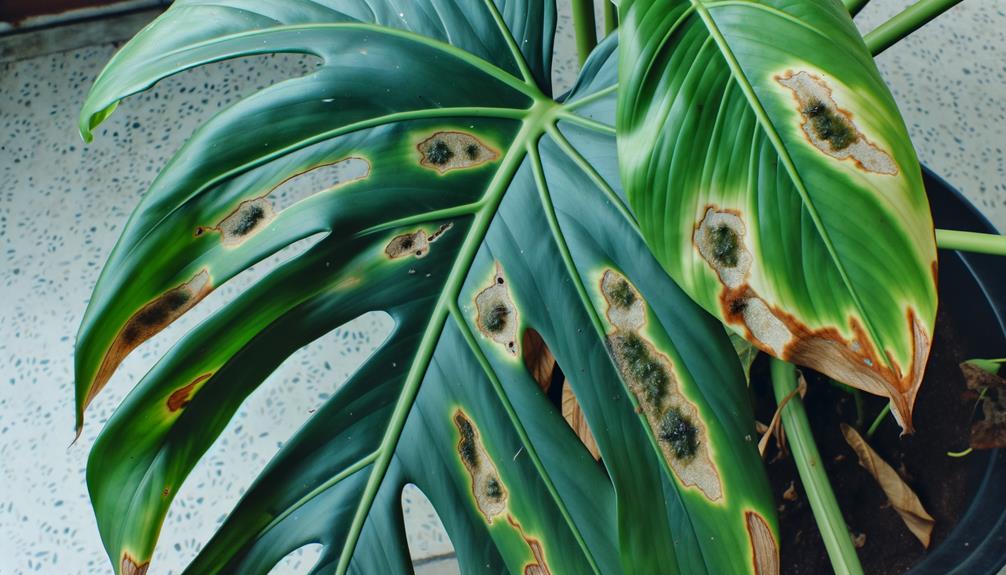
You should monitor your Monstera Lechleriana Variegated for common pests like Tetranychus urticae (spider mites) and Pseudococcidae (mealybugs). Identifying these pests early can prevent severe infestations that compromise plant health.
Additionally, implement preventative measures against diseases like Pythium root rot by ensuring proper drainage and avoiding excessive watering.
Identifying Common Pests
In dealing with Monstera lechleriana variegated, you’ll often encounter common pests such as spider mites (Tetranychidae), mealybugs (Pseudococcidae), and aphids (Aphidoidea), which can cause significant damage if not managed promptly.
- Spider mites (Tetranychidae): These tiny arachnids form webbing on leaves, causing stippling and yellow discoloration.
- Mealybugs (Pseudococcidae): These pests appear as white, cotton-like masses on stems and leaves, secreting honeydew that leads to sooty mold.
- Aphids (Aphidoidea): These small, soft-bodied insects cluster on new growth, sucking sap and causing leaf curl and stunted growth.
Regularly inspect your plant for these pests, focusing on leaf undersides where they often hide. Identifying and addressing infestations early helps maintain plant health.
Preventing Plant Diseases
To effectively prevent diseases in Monstera lechleriana variegated, prioritize proper sanitation practices and ideal growing conditions, validating the plant’s environment is less conducive to pathogens like Phytophthora root rot and Xanthomonas leaf spot.
Regularly sanitize gardening tools and use well-draining soil to avoid waterlogged conditions. Maintain humidity between 60-80% and provide adequate airflow to deter fungal growth.
Inspect plants frequently for signs of infection or pest infestations, such as yellowing leaves or black spots. Remove and dispose of any affected foliage immediately. Implement an integrated pest management strategy to control common pests like spider mites (Tetranychus urticae) and mealybugs (Pseudococcidae).
Propagation Methods
One effective method for propagating Monstera lechleriana variegated is through stem cuttings. It is essential to ensure that each cutting has at least one node and aerial root, as this technique maximizes the chances of successful growth.
First, select a healthy stem with variegated leaves and cut just below a node. Next, place the cutting in water or sphagnum moss to encourage root development. Finally, transfer the rooted cutting to a well-draining potting mix.
- Selection of Cutting: Choose a stem with at least one node and aerial root.
- Root Development: Submerge in water or sphagnum moss until roots form.
- Transplanting: Move the rooted cutting to a pot with aroid-specific soil mix.
Monstera Lechleriana Variegated Mature
The Monstera Lechleriana Variegated is a rare and highly sought-after plant known for its unique variegated foliage. It features large, lush leaves with distinctive holes (fenestrations) near the central vein, showcasing patches of white or cream against a green background.
Native to the rainforests of Central America, particularly Mexico and Panama, this climbing plant can reach significant heights when provided with proper support.
In terms of care, it thrives in bright, filtered sunlight while avoiding direct sunlight to prevent leaf burn. Regular watering is essential, but the plant prefers well-draining soil to avoid root rot. High humidity and warm temperatures are ideal for optimal growth, and it flourishes in moist, airy soil.
The market value of the Monstera Lechleriana Variegated can vary widely based on size and condition, with prices ranging from around $87.50 to over $2,200.
Generally considered low to moderate maintenance, this hardy plant requires attention to maintain its stunning variegation. When purchasing, it’s common for sellers to offer professional packing and, in some cases, phytosanitary certificates for international shipping.
This plant is a prized addition for collectors due to its rare variegation and striking appearance.
Conclusion
Essentially, nurturing a Monstera lechleriana variegated isn’t solely about plant care—it’s an art form. By grasping its beginnings, distinct variegation patterns, and optimal growing conditions, you’ll excel at meeting its requirements.
Ward off pests such as spider mites and aphids, and employ accurate propagation methods to increase your assortment.
Keep in mind, a flourishing Monstera lechleriana variegated isn’t just a plant; it showcases your horticultural expertise. Thus, embrace the challenge and watch your gardening skills thrive!


